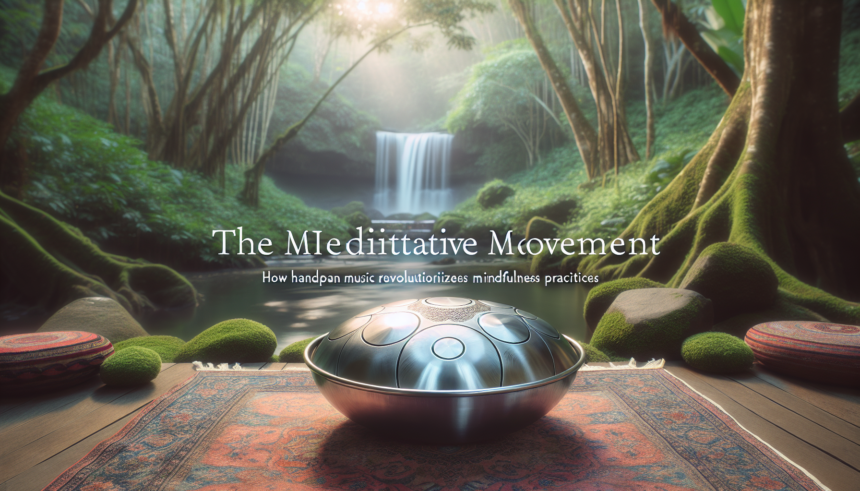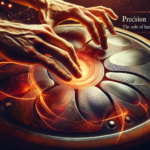<!DOCTYPE html>
<html lang="en">
<head>
<meta charset="UTF-8">
<meta name="viewport" content="width=device-width, initial-scale=1.0">
<title>The Meditative Movement: How Handpan Music Revolutionizes Mindfulness Practices</title>
</head>
<body>
<p>In today's fast-paced world, the need for mindfulness and relaxation techniques has never been more pressing. With stress levels and anxiety on the rise, finding ways to stay calm and centered is critical for maintaining mental and physical well-being. Meditation and mindfulness practices have thus become increasingly popular, offering individuals a reprise from the clamor of everyday life. Amidst these practices, handpan music has emerged as a transformative force, acting as a conduit for deeper meditative states and enhanced mindfulness experiences.</p>
<h2>The Handpan: A Breathtaking Instrument</h2>
<p>The handpan, a relatively recent addition to the world of musical instruments, was invented in the early 2000s in Switzerland by Felix Rohner and Sabina Schärer. These steel instruments are known for their ethereal, calming sounds, capable of producing a wide range of tones and harmonics. The unique design of the handpan, with its central note surrounded by a circle of other notes, allows it to produce a resonance and complexity of sound that is unmatched by other instruments.</p>
<p>Handpans are often played by hands rather than with mallets, arranging soothing melodies through gentle touches and taps. This tactile interaction gives musicians a more intimate connection with the instrument, allowing them to convey emotions and stories through their music effortlessly. The sonic qualities of the handpan create a serene atmosphere, transporting listeners into an immersive soundscape where time seems to slow down, making it an ideal companion for mindfulness practices.</p>
<h2>Handpan Music in Mindfulness</h2>
<p>The rhythmic and melodic nature of handpan music brings a distinct dimension to meditation and mindfulness exercises. Its ability to create an ambient soundscape complements the meditative ambiance, helping listeners to sink deeper into their practice.</p>
<p>One of the fundamental aspects of mindfulness is focusing on the present moment, and the handpan facilitates this by guiding attention away from distracting thoughts and towards the soothing sound of music. This focal point acts as an anchor, helping individuals maintain their awareness in the 'here and now.' As such, handpan music is not only a background element but an integral part of the mindfulness experience, encouraging deeper levels of concentration and relaxation.</p>
<h2>Handpan Music and Its Psychological Benefits</h2>
<p>The hypnotic melodies produced by the handpan have been shown to have various psychological benefits. Studies suggest that listening to calming music like that of the handpan can lower cortisol levels – the hormone associated with stress. This reduction in stress can lead to improved mental health, increased emotional stability, and enhanced cognitive function.</p>
<p>The repetitive nature of handpan sound patterns can be meditative, similar to traditional mantra-based meditation practices. These patterns can aid in reducing the monkey-mind effect, a term used to describe the constant chatter of thoughts in the human brain. By focusing on the recurring musical motifs, one can induce a state of mental stillness and clarity, fostering a serene mental environment conducive to meditation and reflection.</p>
<h2>Handpan Music and Its Physiological Benefits</h2>
<p>Beyond psychological advantages, handpan music can have positive physiological effects. The calming sounds can induce a slower heart rate and deep breathing, both essential components of the relaxation response. These physiological changes can help to alleviate tension and promote the body's natural healing processes.</p>
<p>The handpan's sound waves can produce vibrations that resonate with different parts of the body, leading to a phenomenon known as sound healing. These vibrations can help to unclog blocked energy pathways, enhancing overall physical wellness. In particular, practitioners of mindfulness and meditation who incorporate handpan music often report feelings of lightness and rejuvenation, attributed to the profound relaxation fostered by the instrument.</p>
<h2>Handpan in Group Meditation and Mindfulness Practices</h2>
<p>Group meditation sessions often utilize music to synchronize participants' minds and bodies, creating a cohesive energy field. Handpan music, with its inclusive and soothing nature, is perfect for these settings. The communal experience of listening to a handpan can amplify the meditative aspects of mindfulness, allowing participants to feel connected not only with themselves but also with each other.</p>
<p>In yoga studios and wellness retreats, handpan music has become a staple, used to set a tranquil atmosphere. Instructors frequently employ it during group sessions to facilitate a harmonious environment, enhancing the overall experience of peace and mindfulness. The enveloping sounds of the handpan can help synchronize breathing patterns and heart rates among participants, creating a shared, collective state of calm and awareness.</p>
<h2>Learning to Play the Handpan as a Mindful Practice</h2>
<p>Playing the handpan itself can be a meditative experience. The act of striking the instrument with one's hands allows musicians to establish a physical and emotional connection with the handpan, enabling them to express themselves creatively. This engagement with the instrument requires concentration and mindfulness, making it an excellent practice for those looking to integrate music into their mindfulness routine actively.</p>
<p>Learning to play the handpan encourages individuals to be present, focusing entirely on the music they are creating. This element of active participation can offer additional mindfulness benefits, as it requires the musician to concentrate on each note, rhythm, and the emotion they wish to convey. Furthermore, as a relatively easy instrument to pick up, the handpan offers even beginners an opportunity to develop a fulfilling mindful practice through music.</p>
<h2>Conclusion</h2>
<p>As the quest for mindfulness and relaxation becomes more critical in our increasingly chaotic world, the handpan stands out as a tool for revolutionizing meditation practices. Its soothing, ethereal soundscapes and ability to foster both psychological and physiological benefits make it an ideal component of any mindfulness routine. Whether as a background for meditation or as an instrument to play, the handpan offers peace, presence, and mindfulness in an increasingly busy world.</p>
<p>By integrating handpan music into their daily lives, individuals may find themselves stepping closer to a state of inner calm and balance, exploring new depths of relaxation and mental clarity. The handpan not only enriches personal mindfulness practices but also creates a harmonious bridge between the mind, body, and spirit, revolutionizing the way we think about meditation and inner peace.</p>
<h2>FAQs</h2>
<ol>
<li><strong>What is a handpan?</strong>
<p>A handpan is a steel musical instrument that produces calming and ethereal sounds. It is played by hand and is known for its unique, resonant tones.</p>
</li>
<li><strong>How can handpan music benefit mindfulness practices?</strong>
<p>Handpan music aids mindfulness by creating a soothing soundscape that helps focus attention and enhance relaxation. It can lower stress levels and promote deeper meditative states.</p>
</li>
<li><strong>Is playing the handpan easy to learn?</strong>
<p>Yes, the handpan is relatively easy to learn compared to other instruments. Its intuitive design allows beginners to quickly start producing pleasant and harmonious sounds.</p>
</li>
<li><strong>Can handpan music be used in group meditation sessions?</strong>
<p>Absolutely, handpan music is excellent for group meditations. Its soothing nature creates a shared tranquil atmosphere, fostering unity and collective mindfulness.</p>
</li>
<li><strong>Are there any physiological benefits of listening to handpan music?</strong>
<p>Listening to handpan music can induce physiological relaxation responses, such as slower heart rate and deeper breathing. It can also complement sound healing practices by resonating with the body's energy centers.</p>
</li>
</ol>
</body>
</html>The Meditative Movement: How Handpan Music Revolutionizes Mindfulness Practices

Leave a comment




